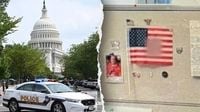On October 15, 2025, a storm of controversy swept through Capitol Hill after a swastika was discovered embedded in an American flag displayed in the office of Ohio Congressman Dave Taylor, a Republican representing several Ohio counties including Brown, Highland, Clermont, Clinton, and Adams. What initially appeared to be a standard Stars and Stripes, pinned behind staffer Angelo Elia, concealed a deeply troubling secret: the infamous Nazi symbol, ingeniously hidden within the flag’s red stripes using an optical illusion that rendered it nearly invisible to the naked eye.
The incident quickly triggered a flurry of concern and condemnation across Washington. According to NBC News, multiple Republican congressional offices reported receiving similar flags, each bearing a swastika artfully camouflaged in the design. In one case, the symbol was so well disguised that it only became apparent after close inspection—or, as Fox News reported, when viewed through a camera or video. In another instance, an aide described a flag where the swastika was drawn with whiteout and black marker, making it “plainly obvious to us that there was a swastika on the flag with the naked eye.” That flag, the aide explained, was simply thrown away “like we would hate mail.”
Congressman Taylor was quick to address the matter publicly, calling it “vile and deeply inappropriate.” In a statement released to FOX19 NOW, Taylor explained, “Numerous Republican offices have confirmed that they were targeted by an unidentified group or individual who distributed American flags bearing a similar symbol, which were initially indistinguishable from an ordinary American flag to the naked eye.” He went on to clarify, “After a full-scale internal investigation, I am confident that no employee of this office would knowingly display such a despicable image, and the flag in question was taken down immediately upon the discovery of the obscured symbol it bore.”
Not stopping there, Taylor reaffirmed his position against hate, stating, “As I’ve said previously, I unequivocally condemn hate in any form and continue to collaborate with Capitol Police and the Committee on House Administration to uncover additional details in this investigation.” The U.S. Capitol Police, for their part, launched an official investigation after the flag was reported, treating the incident as a case of office vandalism.
While the identity of the person or group responsible for distributing these altered flags remains a mystery, the episode has sparked wider discussions about the infiltration of hate symbols into American political spaces and the potential motives behind such acts. According to Politico, another image surfaced showing a flag with a swastika created by manipulating the stripes with whiteout and black marker, reinforcing the notion that the campaign was deliberate and targeted. The altered flags, distributed to “numerous Republican offices,” were described by Taylor and others as part of a coordinated “ruse.”
The timing of the incident only added fuel to the fire. Just days prior, a Young Republicans group chat was exposed by Politico, revealing a torrent of racist and homophobic slurs, as well as chilling threats. In one particularly disturbing exchange, Peter Giunta, the former chairman of the New York Young Republicans, wrote, “Everyone that votes no is going to the gas chamber,” referring to a leadership vote. He also declared, “Great. I love Hitler,” after a discussion about Michigan’s Young Republicans potentially supporting a far-right candidate. Annie Kaykaty, a national committee member, reportedly said she was “ready to watch people burn now.” The revelations from the group chat, coupled with the flag controversy, have intensified scrutiny of extremist rhetoric and imagery within certain Republican circles.
For Taylor, the discovery of the swastika flag was both a personal and professional affront. In his official communication, he insisted, “The content of that image does not reflect the values or standards of this office, my staff, or myself, and I condemn it in the strongest terms.” He emphasized that the flag was removed immediately and that his office was cooperating fully with authorities: “I am working with Capitol Police and the Committee on House Administration to uncover additional details in this investigation.”
The peculiar method by which the swastika was hidden—using an optical illusion within the flag’s stripes—has raised questions about the sophistication of the perpetrator and their intentions. Fox News noted that the design was so subtle, it was only visible on camera, suggesting a calculated effort to sow discord and embarrassment. Some aides, however, found the alterations more blatant, as in the case of the flag marked with whiteout and black marker. Regardless of the method, the message was clear and deeply unsettling.
This incident is not the first time symbols associated with hate have crept into the political spotlight. As The Independent pointed out, the Trump administration has faced criticism over alleged connections to Nazi symbols since the president’s inauguration. One particularly controversial moment occurred at a Republican leader’s inaugural rally, where former Trump ally Elon Musk was seen making a gesture some claimed resembled a “Heil Hitler salute.” While supporters insisted it was a “Roman Salute,” critics, including Rep. Alexandria Ocasio-Cortez, argued otherwise, highlighting the ongoing sensitivity around such imagery in American politics.
For many, the recent events underscore a broader challenge: ensuring that symbols of hate do not gain a foothold in the nation’s most hallowed institutions. Taylor’s unequivocal condemnation and swift removal of the flag have been echoed by other Republican offices targeted in the ruse. Yet, the lack of a clear culprit and the ongoing investigation mean that tensions remain high. According to Taylor, “New details have emerged from a coordinated investigation into the vile symbol that appeared in my office,” but as of now, the origins of the altered flags remain shrouded in mystery.
Meanwhile, the exposure of hateful rhetoric in the Young Republicans group chat has prompted renewed calls for accountability and introspection within the party. The juxtaposition of these two incidents—a physical symbol of hate and digital expressions of extremism—has left many wondering about the extent of such sentiments and the measures needed to counter them.
As the Capitol Police continue their investigation and party leaders grapple with the fallout, one thing is certain: the presence of a swastika, even hidden in plain sight, serves as a stark reminder of the vigilance required to protect democratic values and ensure that hate has no place in the halls of American government.





